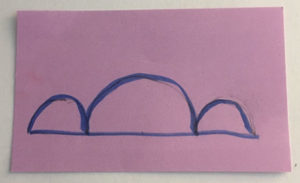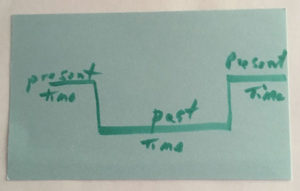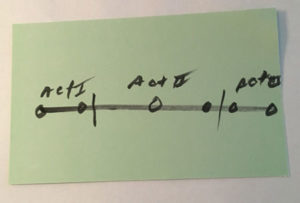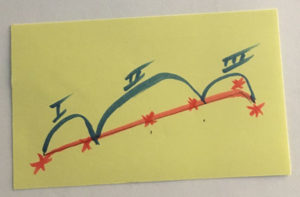
Some of you have asked me about terminology I’ve used recently in my Tuesday #writingtips and #writetips. Or possibly you’ve wondered about my using an inverted check mark to represent plot, so today I’ll explain an excerpt from Novel Basics, my compact yet complete guide to writing a novel.
Note: my illustrations may appear a bit unfinished because one of the points I make in Novel Basics is that writers can jot down the basic ideas they need to start a novel on twenty 3″ X 5″ index cards in about ninety minutes.
A Brief History of Plot

Way back in 4th Century BCE, the Greek philosopher Aristotle gave the first guidelines to plot structure when he said that a tragedy needs three parts: beginning, middle, and end, later called Act 1, Act 2, and Act 3. He also stated that the beginning isn’t necessarily preceded by any significant action, the middle grows out of the beginning, and the end grows out of middle. A successful plot might contain a surprise like some sort of shift in the action or finding out a secret from the past.
This very simple statement belies all the variations, refinements, arguments and applications to assorted kinds of storytelling that have developed since that time. Those variations included that of Horace, a Roman poet, who later said that a play needed five acts. Both Aristotle and Horace were talking about stories performed on a stage with live actions. Some differences and divergences of how plots were structured came about with the novel.
One of the earliest ways extended fiction was structured was the still popular picaresque plot, so named because Miguel de Cervantes used this type of plot in Don Quixote, first published in 1606, in which the hero and his sidekick, a rascal or picaro named Sancho Panza, go on one adventure after another.

The picaresque plot tends to have a bunch of episodes loosely strung together, that is, just one darned thing after another. You might recognize it from the very popular Fifty Shades of Grey. (Honestly, I haven’t read that novel. But a friend of mine read the first few chapters and reported that the book seemed episodic to her.)

Charles Dickens structured The Pickwick Papers, first published in installments in 1836, in similar fashion though he did frame the adventures with an overall story about Pickwick’s wedding proposal to a woman who sued him for breach of promise for not following through at the end of the novel.
I’ll omit some of the other variations of plot structure and skip to Syd Field’s Screenplay: The Foundations of Screenwriting, first published in 1979.

Field said that successful movies tend to have three parts: Act 1 that runs for about thirty minutes (about thirty script pages), Act 2 that runs sixty minutes (about sixty pages), and Act 3, that runs to no more than thirty minutes. Field also says that a successful movie has six essential scenes.
Not long after that, Robert J. Ray in The Weekend Novelist described the structure of a novel as similar to Field’s paradigm, but with more pages in each act because the novelist must put much more on the page than the screenwriter does. Suffice it to say that the plot of a novel needs several scenes, six or even as many as nine including scenes that cut up the large Act 2 into manageable parts.
Scriptwriters are often so precise about bringing in the essential scenes that you can time them. “Hey, hey, wait for it. Wait for it. Ah, here comes Plot Point 1, right on schedule at minute 29.” Novelists generally aren’t so precise about hitting the plot points, but still successful novels usually place these important scenes at fairly regular intervals.
Somerset Maugham, author of almost twenty novels, once famously said, “There are three rules for writing a novel. Unfortunately, no one knows what they are.” That hasn’t kept other writers from writing books on the subject and coming up with more rules, up to ten in one instance. My own take on this is that the novel you write tells you what it needs and wants to be as you write it, including decisions on structure. For example, although the classical template might dictate otherwise, Suzanne Collins divided The Hunger Games into three parts, all about the same length: Part I–138 pages, Part II–106 pages, Part III–130 pages.
As for myself, a writer primarily of mystery fiction, I prefer a more logical plot than the picaresque novel has, not one darned thing after another, but a tightly connected chain of events: that is, one more thing happens because of what happened before and the whole situation getting more and more complicated until things come together in a big scene in which the whole situation gets resolved.

My favorite representation of plot is the inverted check mark with the three major acts and the six major scenes overlaid on it because this diagram shows how the action and the tension of a well plotted novel build to the highest point of intensity in the book that’s resolved before its end.
Instead of thinking of plot structure as a formula, think of it as a skeleton, the bare bones on which you need to build your novel.

Novel Basics is available in print for $8.99 (ISBN: 9781730833991). The digital version of Novel Basics costs only $0.99 from October 9 through October 15, 2019–just in time for you to use it to prepare for NaNoWriMo 2019–at http://www.amazon.com/dp/B07K2LXFRP and £0.99 at http://www.amazon.co.uk/dp/B07K2LXFRP
